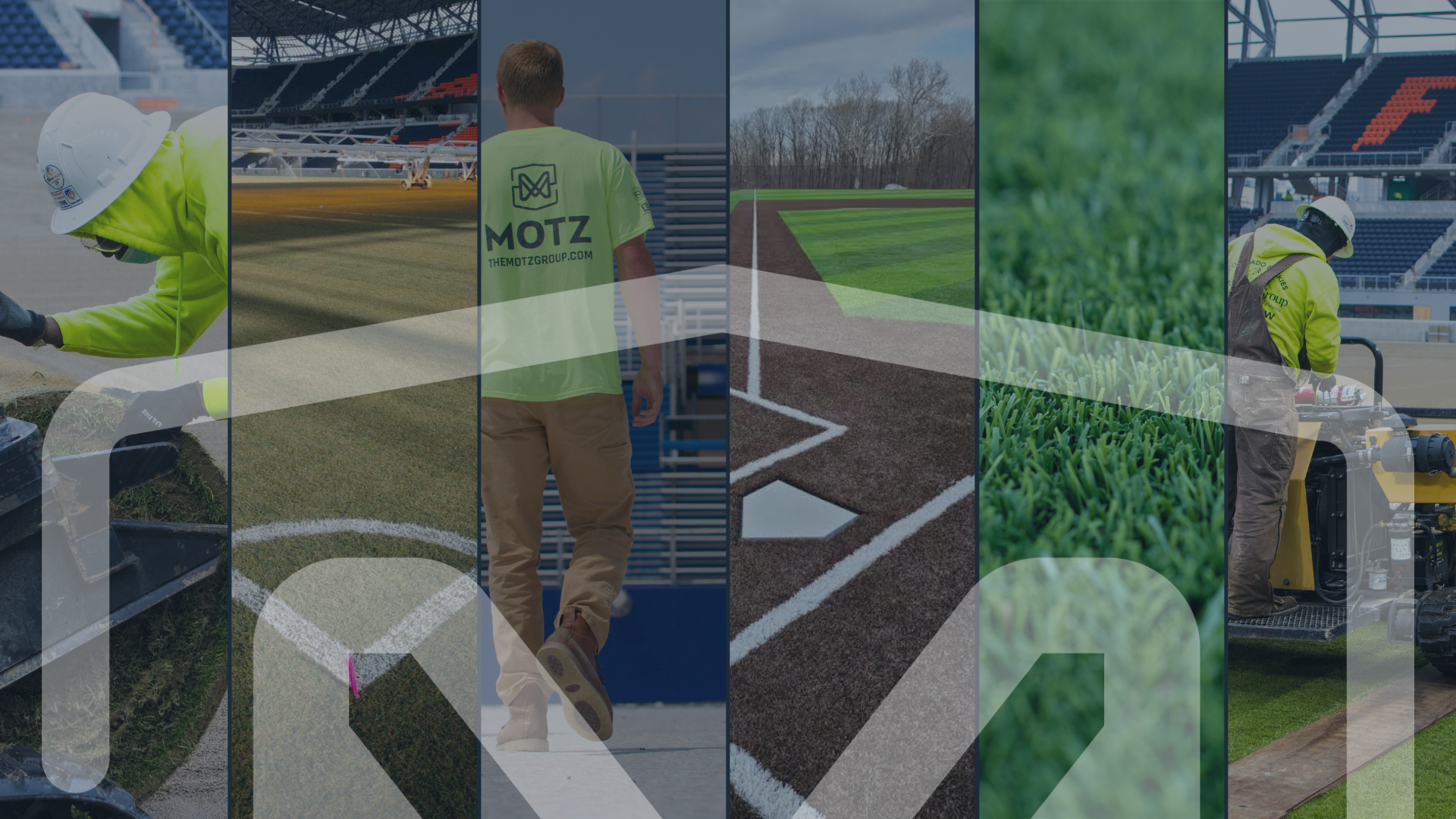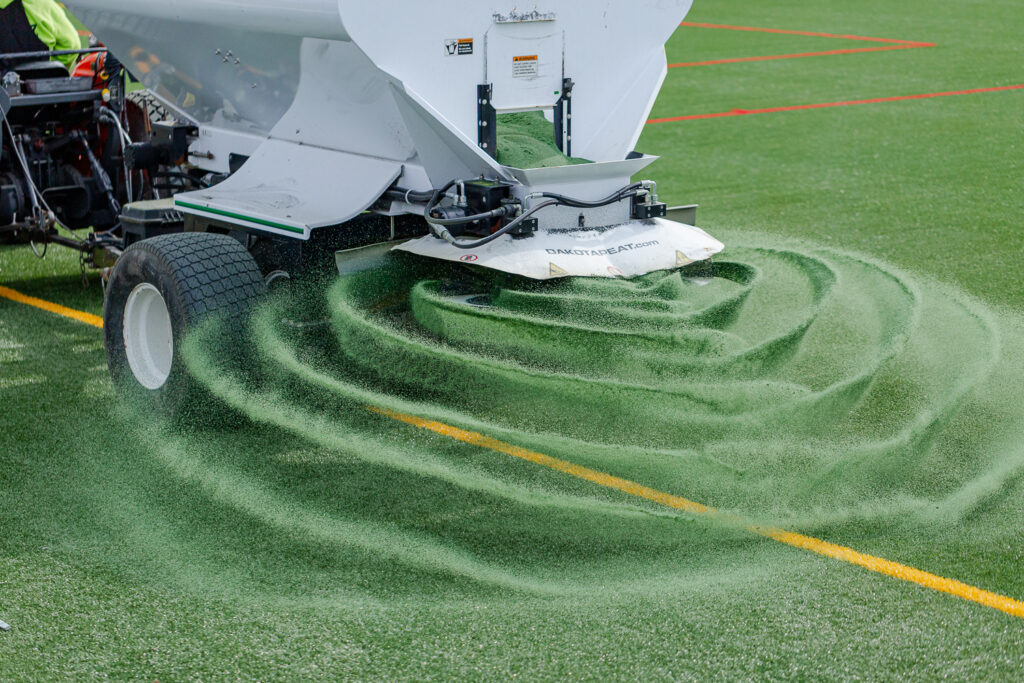
Sports Field Blog
Subscribe To Email Updates
Subscribe to our weekly newsletter and we’ll send updates straight to your inbox
A Q&A: Infill’s Role When Painting a Field
We had a chance to catch up with Jeff Fisher, Synthetic Turf Product Line Manager at Pioneer Athletics. Pioneer is another Ohio-based company with a long history in the sports field market. They specialize in the paints used by sports field managers and from the little league all the way to the professional fields and everywhere in between. If you want to know about paints, these are the guys to call.
Q&A With A Sports Facility Manager about Infills Role In Painting A Field
Meet Jeff Fisher, Synthetic Turf Product Line Manager at Pioneer Athletics
In our Q&A with Jeff, we explored the topic of infill’s role in painting a field. This is a topic that is rarely considered during the buying process but something that will come into play week after week as your sports facility manager hustles to prepare the field for a wide range of sports by painting, removing and re-painting the field in multiple configurations. The type of infill you select will have a big impact in how easy it is to manage this process and get the most out of your field.
What should a field owner consider when painting a synthetic turf field, as far as their infill is concerned?
- The key to painting a synthetic turf field is to use the proper paint, equipment and technique to cover the fibers evenly while minimizing the amount of infill that gets painted. Infill height or infill exposure can make this a challenge, if not impossible to avoid. Often both the turf and infill will receive paint, in that cases, the best approach is to, apply a clear coat to fill in the scratches in the turf fiber and seal the infill. The clear can stay in the nooks and crevices. This allows the color to easily come off at the time of paint removal. Also, painting light, either using a finer tip than normal or an aerosol, to minimize the amount of paint that reaches the infill, can drastically reduce the issue. –This is a common problem on new fields, before the infill has settled, and taking either one of these steps can greatly reduce infill painting.
- With highly absorbent materials, the characteristics of the infill particles can change the first-time paint is applied and that change can last a very long time because the pores and crevices of the material are filled with paint that won’t easily be removed. One potential way around this is to soak the field with water where the painting will occur. The turf fiber dries but the infill will stay saturated which results in less paint absorption. Results are better on a slit film than a monofilament system because there is typically less infill exposure. This will extend dry times of the paint, so one will need to plan accordingly.
- Synthetic turf paints applied during an air temp of 50o-75oF with normal humidity will take about four hours to dry to the touch and 2 to 3 days to fully cure. Things that can impact drying/curing times include dew, rain and high humidity which can re-liquify the paint extending these times. This is not the case for aerosol paints, which dry in a few minutes and will not rewet.
- Adding water to the field to temporarily decrease temperature or saturate the infill will increase humidity.
- Removable paints are designed to last 2 weeks – 3 months. Non-removable paints are also available that can last about 1-2 years.
What is the process for removing paints from a synthetic turf field?
- We recommend first using a dry brush (ie a drag broom on gator or Blitz walk behind scrubber) to break up and stand up the fibers. Second, apply a remover solution. The solution should be kept down long enough to activate the paint (about 30 sec which can vary depending on the paint and environment.) A scrub brush is then used to break up the paint and water is used to rinse it through the infill. One way to speed up the process and prevent paint from building up in your system, is to use a Prex extractor which removes paint like a large carpet cleaner. Warm water works best although most facilities won’t have that luxury.
- Removing paint after a rain or presoaking the painted areas can help, although it isn’t always necessary. If you do have an absorbent field, pre-soaking the area to be removed should help minimize residual paint while removing.
Since it’s been around for nearly 20 years and widely used, can you talk to us about crumb rubber and how it impacts the paint application and removal process?
- It’s not a bad infill as it relates to painting and paint removal.
- How its created (cryo or ambient) does not matter as much as its surface and regularity.
- Similar size and smooth surfaces are preferred.
- SBR is an issue when painting a 6’ border due to the contrast between the black particles and white painted infill.
How about other infill products like EPDM or TPE?
- EPDMs with uneven surface can stain or hold paint more easily.
- TPE has a smoother surface thus doesn’t absorb or hold residual paint particles well.
You mentioned clear coat is the best product to use before applying paint. Can you explain the clear coat and what it does?
- The clear coat is essentially part of the paint resin without pigment.
- Not designed to penetrate fully.
- Clear Coat essentially creates a barrier between the substrate and the paint, allowing for easier removal. It also fills in the scratches and irregular surfaces, preventing pigment particles from getting stuck there.
- It is recommended when painting over sewn or glued-in colored turf and when infill exposure is high.
What infill characteristics are important for the painting/removal process?
- Surface texture: The smoother the surface, the easier the removal.
- Colors: Medium tones hide colors the best; Lighter tones show darker paints; Darker tones show lighter paints
- Absorption rates: Highly absorbent infills like coconut fiber are challenging to paint and remove paint. The paint absorbs very deep into the infill and does not release. Some products take on the properties of plastic when the voids are filled with paint. The particles becomes very dense.
Ghosting. What is it? How to prevent it?
- Ghosting is a small imperfection in the surfaces (turf and/or infill) that has paint on it that is unable to be removed. When viewed from a distance the old lines can be seen, like a faint ghost. These can haunt sports facility managers for weeks and months after the removal process, but using the right paint and techniques, like the ones above, can eliminate this issue.
“Haunt” sports facility managers. I see what you did there. You’ve see a lot of different infills over the years and have taken a close look at some of ours. How does Envirofill perform? (compared to rubber as the baseline?)
Envirofill is easily the best performing infill when it comes to holding paint and removing it.
How does Safeshell perform? (compared to rubber as the baseline?)
The pores of a Safeshell particle are small, smooth surface and even though there is a slight hold of the paint, the dark (neutral) color does not result in a big color shift.
What are some things for a field owner to consider on the front end of a project if trying to select between infills?
If considering a green field, and going to paint the lines and logos, Envirofill would be a better selection than Safeshell although neither would be as difficult as other natural infills that are more absorbent, (ie coconut fiber.)
What is the worst case scenario for a field when it comes to painting?
An overly filled, low density monofilament, with a lot of absorbent or irregular infill near the top layer is about as tough as you can get. In this situation, the exposed infill material will be painted more heavily than normal, the infill will hold the paint more aggressively than a less absorbent and smooth one, making it difficult to remove completely.
Thanks for catching up with us, Jeff!
Similar Blogs



